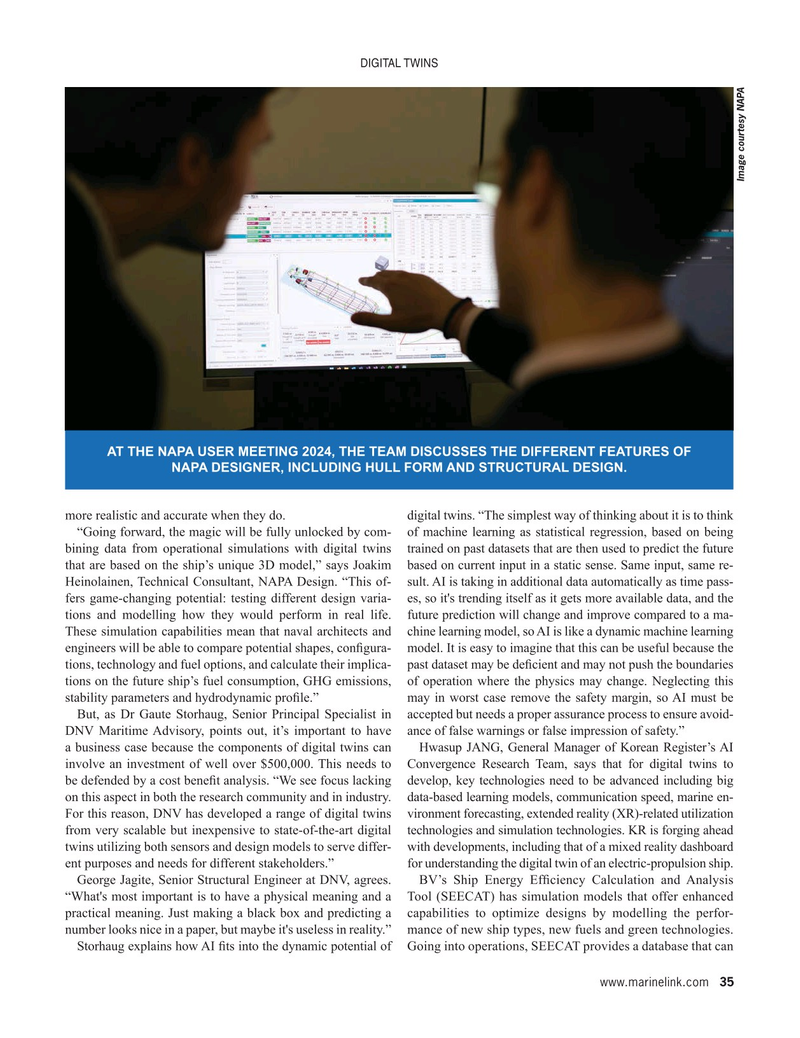
Page 35: of Maritime Reporter Magazine (September 2024)
Read this page in Pdf, Flash or Html5 edition of September 2024 Maritime Reporter Magazine
DIGITAL TWINS
Image courtesy NAPA
AT THE NAPA USER MEETING 2024, THE TEAM DISCUSSES THE DIFFERENT FEATURES OF
NAPA DESIGNER, INCLUDING HULL FORM AND STRUCTURAL DESIGN.
more realistic and accurate when they do. digital twins. “The simplest way of thinking about it is to think “Going forward, the magic will be fully unlocked by com- of machine learning as statistical regression, based on being bining data from operational simulations with digital twins trained on past datasets that are then used to predict the future that are based on the ship’s unique 3D model,” says Joakim based on current input in a static sense. Same input, same re-
Heinolainen, Technical Consultant, NAPA Design. “This of- sult. AI is taking in additional data automatically as time pass- fers game-changing potential: testing different design varia- es, so it's trending itself as it gets more available data, and the tions and modelling how they would perform in real life. future prediction will change and improve compared to a ma-
These simulation capabilities mean that naval architects and chine learning model, so AI is like a dynamic machine learning engineers will be able to compare potential shapes, con? gura- model. It is easy to imagine that this can be useful because the tions, technology and fuel options, and calculate their implica- past dataset may be de? cient and may not push the boundaries tions on the future ship’s fuel consumption, GHG emissions, of operation where the physics may change. Neglecting this stability parameters and hydrodynamic pro? le.” may in worst case remove the safety margin, so AI must be
But, as Dr Gaute Storhaug, Senior Principal Specialist in accepted but needs a proper assurance process to ensure avoid-
DNV Maritime Advisory, points out, it’s important to have ance of false warnings or false impression of safety.” a business case because the components of digital twins can Hwasup JANG, General Manager of Korean Register’s AI involve an investment of well over $500,000. This needs to Convergence Research Team, says that for digital twins to be defended by a cost bene? t analysis. “We see focus lacking develop, key technologies need to be advanced including big on this aspect in both the research community and in industry. data-based learning models, communication speed, marine en-
For this reason, DNV has developed a range of digital twins vironment forecasting, extended reality (XR)-related utilization from very scalable but inexpensive to state-of-the-art digital technologies and simulation technologies. KR is forging ahead twins utilizing both sensors and design models to serve differ- with developments, including that of a mixed reality dashboard ent purposes and needs for different stakeholders.” for understanding the digital twin of an electric-propulsion ship.
George Jagite, Senior Structural Engineer at DNV, agrees. BV’s Ship Energy Ef? ciency Calculation and Analysis “What's most important is to have a physical meaning and a Tool (SEECAT) has simulation models that offer enhanced practical meaning. Just making a black box and predicting a capabilities to optimize designs by modelling the perfor- number looks nice in a paper, but maybe it's useless in reality.” mance of new ship types, new fuels and green technologies.
Storhaug explains how AI ? ts into the dynamic potential of Going into operations, SEECAT provides a database that can www.marinelink.com 35
MR #9 (34-44).indd 35 9/2/2024 9:35:58 PM

 34
34

 36
36
